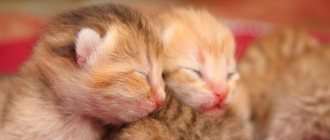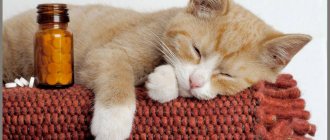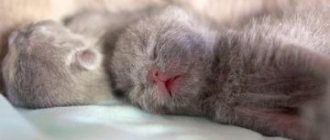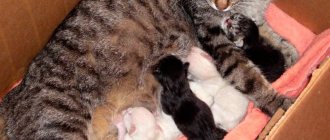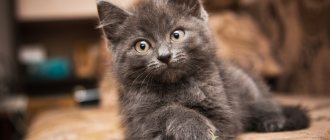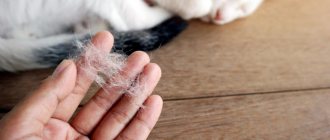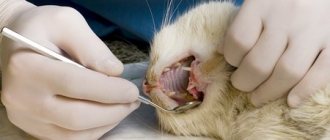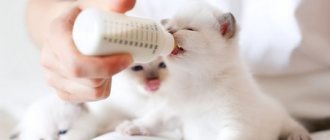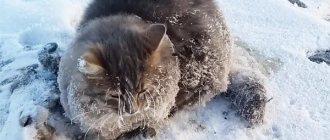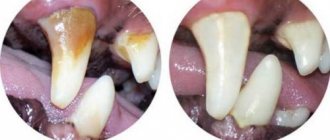Cat owners have a lot of questions about raising and keeping purrs at home. Today we will discuss one very important topic, it concerns teeth. So, let's begin…
When kittens are born, there is not a single tooth in their mouth. At two weeks of age, the first incisors erupt. By the tenth week, a set of baby teeth appears. Many people are interested in how kittens change teeth and the age when babies become the most biting.
At ten weeks, purrs already have a full set of baby teeth. By the way, how many of them does the kitten have? There are twenty-six in total. Around the third week of life, the incisors appear, after seven to ten days the canines appear, and the last to emerge are the premolars. As a rule, they appear painlessly. At this time, no one worries: neither the kitten nor the owners. After this, the kittens begin to change their teeth. It is impossible to name the exact period when this happens, since everything is individual. Usually, by the age of seven months, kittens have all their teeth.
The shift period brings a lot of trouble. At about three to four months, kittens begin to change to permanent teeth. The incisors are replaced first, followed by the canines. The last ones are premolars and molars.
By the way, how many permanent teeth do cats have? The purrs have exactly thirty of them. There are two canines and three incisors on the lower and upper jaws. The upper jaw has four molars (one molar and three premolars), and the lower jaw has three (two premolars and one molar). Note that every third molar is the largest.
Here is the dental formula for an adult cat: three incisors, one canine, three premolars, three incisors, one canine, 2 premolars.
In what order do they change? First, the incisors erupt (at four months), then the canines emerge after two or three weeks, and then approximately the premolars and molars (at four to six months).
Changing teeth in kittens: symptoms of the process
As a rule, everything happens asymptomatically. But let us still highlight one sign of this phenomenon – excitability. The animal may be in this state while eating or drinking liquid. You may also lose your appetite. Weakness and lethargy are also signs of changing teeth. Sometimes there is also drooling and soreness in the mouth.
What can be done to prevent the change of teeth in kittens from developing into a tragedy? We need something to occupy their teeth. Special toys are suitable for this. They are simply irreplaceable during this period. To make the toy better soothe your gums, freeze it first. The more such things, the better.
How many teeth does an adult cat have?
A healthy adult cat has the following types of dents:
- Incisors: small teeth located on the front of the mouth. Each jaw has 6 incisors, a total of 12. Necessary for catching prey, as well as holding it. These are the most vulnerable parts of the mouth. They are held in place by one shallow root and are the first to fall out with age.
- The fangs are designed to tear prey apart. They are bordered by rows of incisors. The total number is 4. They are held in the jaws by one buried root.
- Premolars, otherwise known as small molars. Located on the sides of the fangs. There are 4 of them on the upper jaw, 6 on the lower jaw, 10 in total. Designed for gnawing and chewing solid food. They sit firmly in the jaws on two or three roots.
- On each side of the small molars there is one large one. Their main purpose is chewing. The top one is supported by one spine, the bottom one by two. Total 4.
Be sure to read:
How much does a cat weigh: table by age and breed, assessment, deficiency, norm and excess
Therefore, a healthy cat should have 30 dents in total. As a result of a congenital anomaly or disease, a cat's mouth may not have a complete set, which becomes the cause of disease. Pseudopolyodontia occurs very rarely when the number of dents exceeds 30. The permanent teeth have erupted, but the milk teeth do not want to fall out. The problem is solved by a veterinary dentist.
Questions
What kind of feeding should be done during this difficult time? Changing teeth in kittens is a rather difficult period, both for the owner and for the babies themselves. In principle, you don’t really need to change your diet. You just need to add foods rich in calcium and phosphorus. You can purchase special fertilizers that contain these substances. There is no need to switch to any special food, since this process is completely natural.
Is it true that kittens develop an unpleasant odor from their mouths when they change their teeth? Yes it is. But the smell will disappear after a couple of months (one or two).
When kittens change teeth, you should not treat them leniently. Don't let them bite or scratch your hands. This behavior can remain in adult cats (then scratches and bites will become much more painful); during puberty, their fun develops into aggression. Therefore, immediately put a taboo on human hands and let the kids chew on special toys.
In what cases is it necessary to contact a veterinarian?
Monitor your cat’s condition when changing teeth so that you can consult a doctor in a timely manner.
If at least one of the pathologies occurs when changing teeth, you must consult a veterinarian.
Inflammation or residual milk teeth are fraught with the formation of malocclusion, pain, and trauma to the mucous membrane. In such cases, the doctor, under anesthesia, will remove all excess growths from the animal’s mouth.
What you should pay attention to (external signs):
- the kitten's apathetic state, lethargy, refusal to play;
- frequent meowing, perhaps the kitten is in pain;
- eats little or refuses to eat at all;
- bad dream.
Internal signs:
- redness or pus appears around the tooth or the place where it was located;
- unpleasant odor from the pet's mouth;
- gum inflammation and redness.
If these signs are detected, you must contact a veterinarian. The doctor will make a diagnosis in time and prevent infections from entering the animal’s mouth, the development of inflammation and malocclusion.
Is it necessary to remove baby teeth from kittens?
If you don’t do this, then what will happen next? If no fangs injure the gums, and new teeth grow smoothly, then there is no need to worry. Now try to gently loosen the kittens' milk teeth. This way you can speed up their loss. You need to start worrying if the old fangs do not fall out by six months. Then they need to be removed (although cats rarely have such problems). It will be necessary to pull out the baby fangs. An excessive number of teeth can lead to trauma to the soft tissues in the mouth, the development of periodontal disease and changes in the bite.
Removal of baby teeth - per canine
The structure of the dental system and all its physiological processes are an important element not only of the cat’s exterior, but also an indicator of the overall development of the body. Significant deviations in the number of teeth, their shape, the quality of the bite, as well as deviations in the time of appearance of milk teeth and the replacement of these teeth with permanent ones may indicate violations of the genetic constitution of not only an individual animal, but also the entire line or family to which it belongs.
About the quality of development of baby teeth
cats are judged by the following indicators:
- time of appearance of baby teeth;
- number of baby teeth;
- quality of bite during the milk period of teeth;
- loss of baby teeth;
- eruption of permanent teeth.
Cats have a total of 26 baby teeth.
P 2, C 1, I 3, I 3, C 1, P 2
P 3, C 1, I 3, I 3, C 1, P 3,
The following types of teeth are distinguished:
- incisors
(
Incisivi
) – for biting off small pieces of meat from bones and as a personal care tool; - fangs
(
Caninus
) - for tearing off pieces of food, and also as a weapon for inflicting bites in defense and attack. - permanent teeth
:
preradical
(false, small molars), or
premolars
(Praemolares) - for tearing pieces of food
truly indigenous
, or
molars
(Molares), which do not have milk precursors - for chewing food.
A lack or excess of baby teeth is considered a pathology. During the period of growth of baby teeth, a bite is formed. The incorrect location of baby teeth in the dental arcade leads to the fact that baby teeth, when the jaw comes into contact with the hard palate, injure it. Kittens are born toothless, and the longer the mother cat feeds the babies milk, the later their baby teeth will begin to grow. Typically, teeth begin to appear by the age of one month. Kittens have only 26 non-permanent teeth. They begin to fall out from 4 to 6 months; in some cases, this process may be delayed, but generally by 9 months in young cats, the change of teeth is completed.
Baby teeth are replaced by
30 permanent teeth
very sharp, cutting surfaces.
M 1, P 3, C 1, I 3, I 3, C 1, P 3, M 1
M 1, P 2, C 1, I 3, I 3, C 1, P 2, M 1
In most cases, during this period the owner is required to monitor the process. It is advisable to examine your teeth several times a week to make sure that the milk teeth do not interfere with the growth of the molars. If the baby tooth does not fall out on its own, but a permanent tooth is already growing in its place, you will have to remove the baby tooth, since the permanent tooth may grow deformed.
Impaired tooth replacement in cats is genetically determined, especially in certain breeds; in these cases, the root of the baby tooth does not undergo resorption to the fullest extent, and as a result, it is held very tightly in the gums and jaw bones. In this case, the molar is forced to grow next to it.
If your cat has a “double row of teeth,” you should urgently seek help from a veterinarian, even if the animal feels fine and does not experience any discomfort.
Do not forget that the presence of persistent baby teeth will lead to the early formation of plaque and tartar, which in turn will result in tooth loss at a young age.
The only treatment for this pathology is the timely removal of persistent milk teeth.
As a rule, removal of primary fangs is performed under general anesthesia.
This helps the animal to avoid significant stress during these manipulations, and also to perform the procedure for removing a baby tooth correctly.
Most often this event is planned. In our clinics, before the operation, the doctor and the owner draw up a document on informed consent to the surgical procedure, after all the risks are explained to the owner.
It is very important that the owner, after anesthesia, has the opportunity to warm the animal.
Help from a veterinarian-dentist
If you notice a double row of teeth on your pet, be sure to contact your veterinarian. Let us note that even with such a pathology, cats behave well, eat well, and play. The presence of such a problem can lead to tartar, as well as more tragic consequences, for example, osteomyelitis.
The only way to solve the problem associated with a double row of teeth is to remove the interfering ones. Of course, such a manipulation can be carried out by a doctor in a veterinary clinic. This is because such operations should be carried out under anesthesia in order to avoid significant stress on the animal, as well as to carry out the procedure for removing a baby tooth correctly.
Possible complications during the period of teeth change
Changing teeth is a natural process that can occur without problems for the animal. However, during the period of active growth of molars, you should inspect the animal’s mouth at least once every few days. It is important to consider that reddish and slightly inflamed gums are normal. However, in some cases complications arise. A caring owner should notice the problem in time and be sure to contact a veterinarian.
The most common complications that are visible to the naked eye:
- Suppuration of the wound at the site of the lost tooth.
- The animal shows anxiety, meows pitifully, and may experience severe lethargy.
- The kitten refuses to eat for two days.
- Very severe inflammation of the gums.
- Wounds appear from a missing milk tooth, in the place of which a permanent tooth has already grown.
- Some of the baby teeth have not fallen out, although the permanent ones have already grown in and the time for changing teeth has already passed.
In these cases, you should take the kitten to the clinic or call a doctor at home.
Don't hesitate to contact your veterinarian, even if your pet doesn't show signs of restlessness, lethargy, etc. A healthy animal also needs control, so veterinarians are very loyal to owners who bring healthy animals for examination and ask to monitor the process of changing teeth.
Gum inflammation
Inflammation of the gums is one of the most common complications during the period of teeth change. A little inflammation is normal, but in some cases it lingers and the gums become red.
Inflamed gums become swollen and red
Signs of gum inflammation:
- the animal is restless;
- refuses to eat due to painful sensations;
- tries to chew more;
- rubs its muzzle against everything in an attempt to relieve pain;
- profuse salivation occurs;
- swelling and intense redness are noticeable.
Of course, it is better to have a veterinarian do the diagnosis and treatment, but gum inflammation may go away when the kitten is switched to softer food.
